ITSE Standard #3: Citizen
Educators inspire students to positively contribute to and responsibly participate in the digital world.
Educators:
3a Create experiences for learners to make positive, socially responsible contributions and exhibit empathetic behavior online
that build relationships and community.
3b Establish a learning culture that promotes curiosity and critical examination of online resources and fosters digital literacy and media fluency.
3cMentor students in safe, legal and ethical practices with digital tools and the protection of intellectual rights and property.
3dModel and promote management of personal data and digital identity and protect student data privacy.




